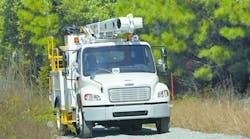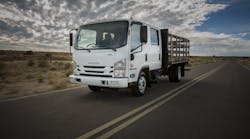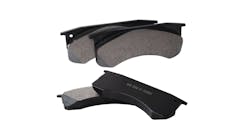The ultimate objective in “building” a vocational truck is to optimize its design for the best overall combination of productivity and cost. “Maximizing productivity may come at an unacceptably high price, but on the other hand, minimizing expenses may result in low productivity and lofty ongoing maintenance costs,” says Bob Johnson, director of fleet relations for the NTEA, the Association for the Work Truck Industry (www.ntea.com).
When working through the spec’ing process, he notes that fleets tend to concentrate on the truck body and mounted equipment while ignoring the chassis. “This does not mean they are overlooking issues such as chassis fuel efficiency and maintenance, but rather, the impact chassis specifications can have on the actual vehicle upfitting costs.
1. THE SECOND UNIT
One of the biggest mistakes that can be made when putting together a vocational truck is to decide on the chassis before designing the body and equipment – the second unit, Johnson says. Along with “the very real chance that the chassis will not be a proper fit for the application, you are missing out on multiple opportunities to reduce upfitting costs.
“In fact, the exact opposite is possible, since the chassis you think you need – even if it is a general match for the equipment being installed – may require modifications to address issues such as component interference.”
Designing the second unit first does two things:
- Helps ensure that the chassis ultimately selected will be a proper match from a capacity and powertrain standpoint.
- Allows OEM features to be incorporated into the chassis that often result in significant upfitting cost reductions.
Potential savings fall into numerous general categories, he says, and highlights several.
- Foundation Components
A number of basic chassis components can have a significant impact on upfitting costs.
“If the manufacturer of the equipment you’re planning to install has any minimum frame requirements, make sure that the chassis you order meets, or exceeds, them,” advises NTEA’s Johnson. “Failure to provide a chassis that meets these requirements can result in the need to reinforce the frame or, in some cases, creates a situation where the equipment cannot be mounted at all on the chassis provided.”
Furthermore, he says to look for chassis/equipment interference problems, such as the placement of air tanks, brake chambers, DEF tanks, battery boxes, etc. Any time an upfitter has to relocate one or more of these components, upfitting costs will increase.
“Just because an option to relocate a component does not appear in the OEM’s ordering guide does not mean it isn’t offered. OEMs have hundreds of pre-engineered special equipment options (SEOs) available to fleets that may address one or more of your issues.”
- Fuel System Modifications
Since vehicle fuel systems are tightly regulated by Federal Motor Vehicle Safety Standards, modifying a fuel system to allow for the pick-up of fuel to power an auxiliary engine or to relocate a tank to avoid an interference issue can not only be costly but may also result in certification issues, notes Johnson. Here again, in many cases, the OEMs offer alternatives, whether in the form of regular production options or SEOs.
- Chassis Electrical Options
Chassis manufacturers offer numerous electrical options that can result in significant upfitting cost savings, Johnson says. These include:
- Pre-installed switches in the cab dashboard. This simplifies the installation of auxiliary electrical components and eliminates the need for the upfitter to work under the dash, avoiding potential future maintenance problems.
- A wiring harness to the roof of the cab for the installation of safety warning lights.
- Chassis multiplexing systems can be used to provide features such as remote engine start/stop/throttle (SST) functions. This eliminates the need for a separate aftermarket SST module.
NOT ALL THE SAME
When considering the use of OEM-provided upfitter options, keep in mind that not every OEM offers the same options and not every vehicle within an OEM’s product line has the exact same features, says Johnson of NTEA. Moreover, chassis options, such as the engine or transmission selection, will also drive other available options.
“This means that if you’re considering multiple OEMs as potential chassis suppliers, you will need to explore the availability of specific options from each OEM and be sure to take these differences into account when evaluating chassis pricing. A lower-cost chassis will not always result in the lowest overall vehicle costs if the unavailability of an option results in a sizable increase in upfitting costs.
2. UPFIT SPECS
Significant reductions in upfitting costs can be achieved “simply by doing a better job of developing your upfitting specifications,” NTEA’s Johnson says. “Conversely, you can significantly increase costs by failing to follow best practices during the design and specification phase of the vehicle acquisition process.”
Before designing a work truck, it’s important to know the tasks it will perform. It is also essential to understand the real versus perceived requirements.
The end-users of the equipment can provide most of the information needed to define the application of a vehicle, says Johnson. However, it is necessary to verify that information to make sure it is accurate.
“You may find that they have over-understated their payload requirements or that you have been given inaccurate figures regarding things such as dimensional and equipment reach requirements. In the process of reviewing user requirements, you may also discover that the equipment will be used for functions that may not have been mentioned or, more commonly, that requirements are included for tasks which are never performed.”
Information from end-users should be a starting point instead of the ending when defining application requirements.
“Failure to follow-up on the information provided to you may result in purchasing the wrong size or even type of equipment,” Johnson emphasizes “Either way, the end results could involve increased upfitting costs, reduced productivity or higher ongoing maintenance expenses.”
UTILIZATION
Another central consideration is equipment utilization. Before arbitrarily replacing a piece of equipment, take the time to see how it is being utilized, counsels Johnson.
For instance, he says, an analysis may find that a piece of equipment with an older design which requires several manual steps to operate is being used every day. In this case, consider upgrading to a more automated piece of equipment to improve productivity, but be sure to review potential gain.
On the other hand, it may be determined that a piece of equipment is used rarely, if at all. In this case, explore options such as downgrading to a lower-cost, less automated component.
“An even more common scenario is that a piece of equipment is being used on a regular basis but the end-users are not utilizing all of its capabilities,” Johnson observes. For example, a digger-derrick is only being used as a crane, or a winch is only being utilized for its extended shaft feature to power a take-up reel or capstan head. “You may be able to downgrade to a lower-cost component that provides the same functionality.”
The whole point of a utilization review is to ensure that the equipment being provided matches the application, he points out. Requirements change regularly as new products and technologies are introduced into the workplace. Even if a design was reviewed several years ago, it’s a good idea to revisited things before ordering another similar unit.
3. TRUCK BODIES
Manufacturers typically offer a wide selection of bodies in just about every style and duty level imaginable, as well a large selection of pre-engineered options that can be added to the basic bodies to further accommodate individual user needs. Nevertheless, fleets often have to modify the manufacturer’s offerings or spec’ custom body designs to accommodate specific job requirements.
“Adding pre-engineered options to a standard body design can be a cost-effective way of addressing specific requirements,” explains Johnson of NTEA. If you cannot address your needs in this fashion, the next level of cost is to make the minimum number of modifications possible to an otherwise standard body.
“As the number of modifications required increases, you will eventually reach the point where it may be just as well to design a totally custom body. When considering a custom body, remember that volume is the important issue.”
There are numerous ways to obtain volume pricing for highly modified or custom bodies, he says. The simplest way is to commit to a specific minimum number of orders over a number of years. Other options include partnering with another user to generate a larger order or just copying an order placed by a larger company.
When considering highly modified or customized truck bodies, “the most important thing is to verify that the modifications are truly justified in terms of improved safety and productivity,” stresses Johnson.
“Before committing yourself and your company to a highly modified or totally custom body, carefully review the user requirements and make a cost-benefit analysis. Even if the user requirements are justified, you may determine that a standard truck body – perhaps with a selection of pre-engineered options – may provide a significant percentage of the perceived benefits without creating a safety issue.
“If you determine that a custom body of a specific style is justified, look at alternative body styles to determine if you can meet the user’s needs by simply switching to a different type of standard body. In some cases, you may end up spending less for what turns out to be a better truck body for an application.”
LEGACY DESIGNS
In many cases, truck bodies are purchased in a specific configuration simply because “that is the way we have always bought them,” says Johnson. “It may be a situation where a given body style was the best available at one point in time, or a custom modification may have been made in the past to address a specific operating requirement that is no longer needed.”
Work practices, tools and materials are constantly changing. By not reviewing the equipment being purchased on a regular basis, “you may get caught in the legacy trap and end up paying more for your truck bodies and equipment than necessary.
“On the opposite side of the coin, you may find that end-user changes have rendered your designs less than optimum. In that case, you may have the opportunity to adopt a better design and reduce costs, while improving the productivity of your fleet at the same time.”
TOTAL VEHICLE INTEGRATION
Vehicles and equipment are getting smarter. The availability of multiplex wiring systems on chassis, coupled with upfitter integration packages and active telematics systems, offer a significant opportunity to reduce total upfitting costs while making vehicles easier to maintain and repair, NTEA’s Johnson says. “When properly utilized, these functions may allow you to simplify second unit wiring, eliminate the need for some add-on control systems, such as start/stop/throttle modules, and provide increased vehicle operating efficiency and improved safety.
Keep in mind that every manufacturer has its own multiplex systems, and each telematics vendor’s system has a specific set of capabilities, he says. Consequently, it is important to get familiar with the capabilities of the various systems in order to make a determination of how to best utilize them in conjunction with a specific vehicle.






